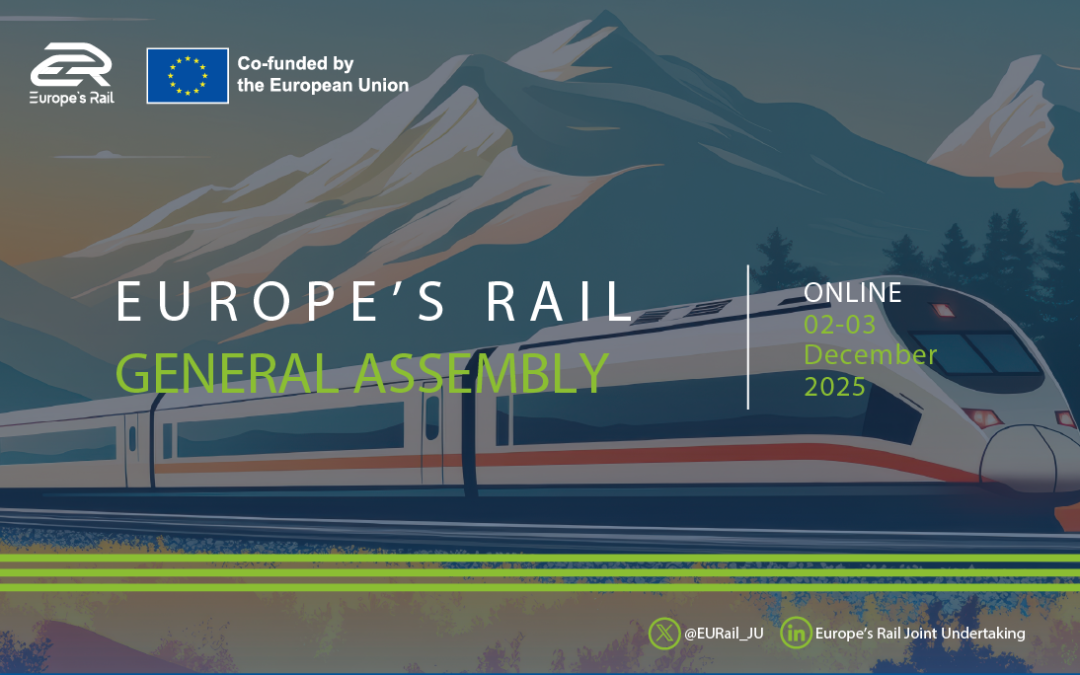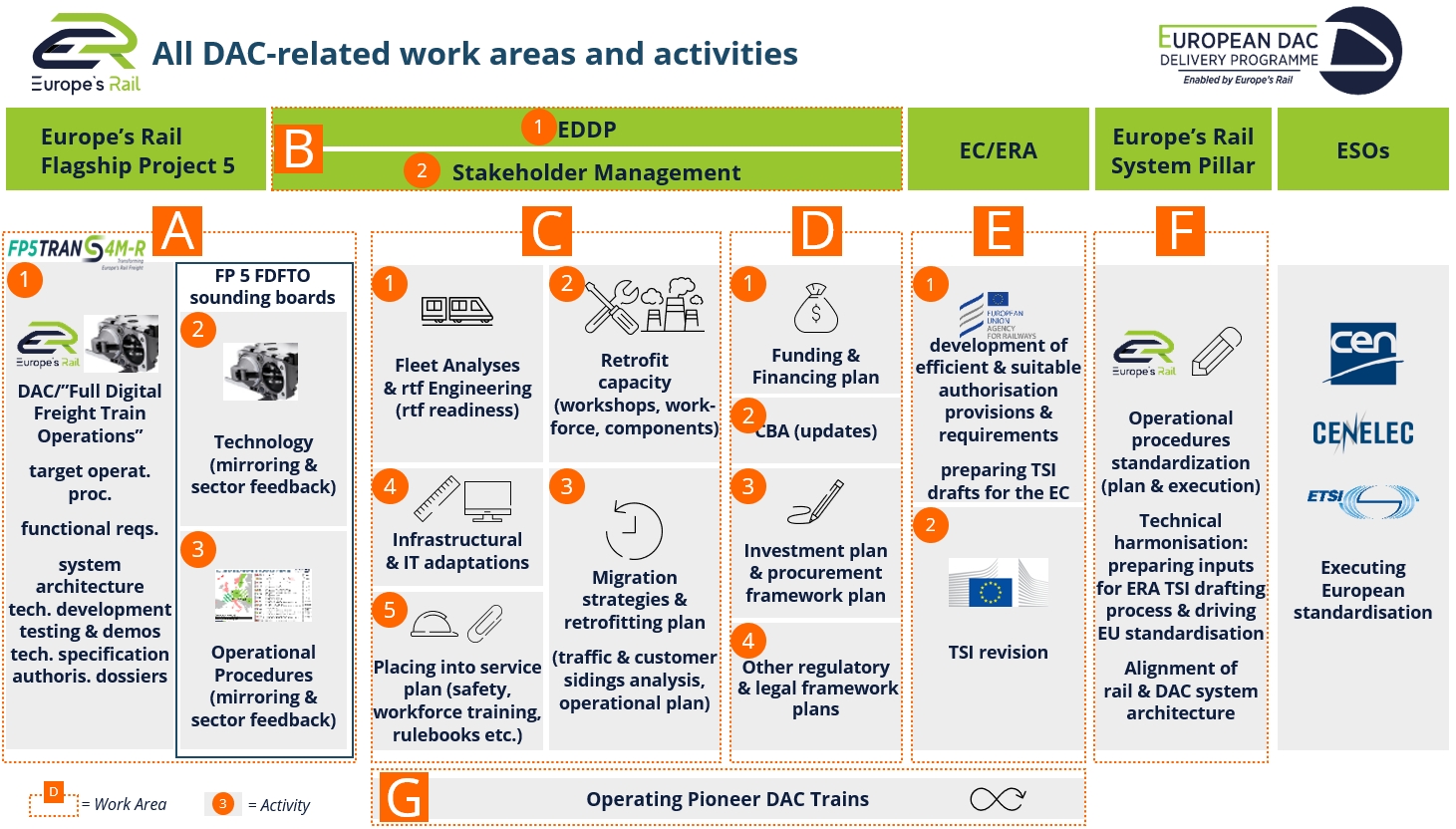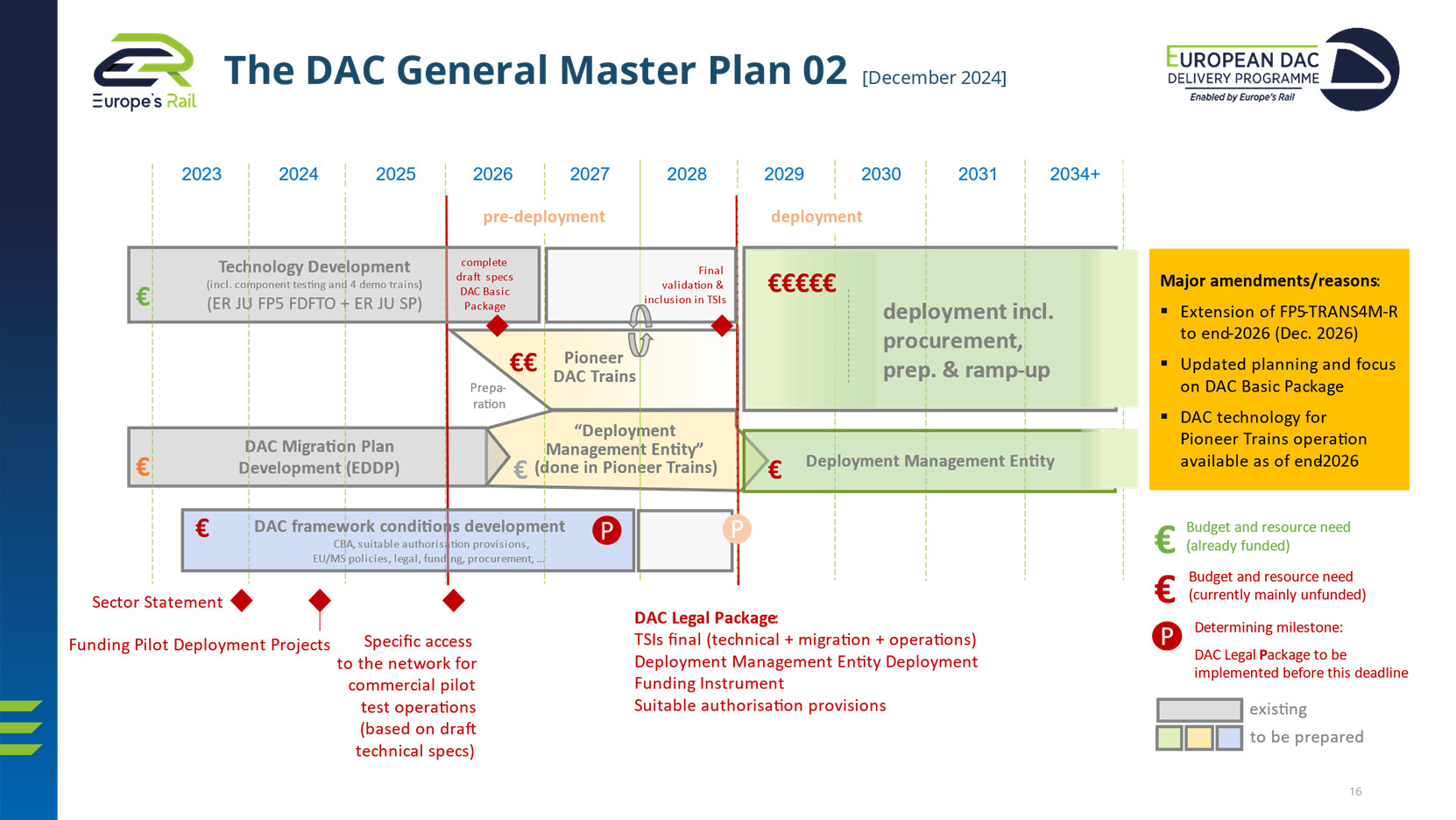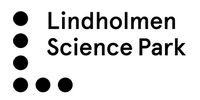On 2–3 December, the Europe's Rail General Assembly 2025 took place, providing a valuable occasion to look back at the...


To allow a fully-fledged technical development of DAC and the DAC applications/ automation components at sufficient budget, the “Full Digital Freight Train Operations” (FDFTO) project was established within the Europe’s Rail Flagship Project 5 (FP5) in the course of 2022.


State of play of DAC developments on target and transitional operational procedures determining the functional requirements for the DAC technical development. This sounding board targets operational procedures for full digital freight train operations (DAC and DAC automation components/train functions) which shall be applicable throughout Europe. Where required, transitional operational procedures to be applied for the migration period and their impact on functional requirements for technology.
Meetings: approx. 2 per year
Required participant expertise: rail freight operations (planning/execution) background
Linked former EDDP WPs: WP 1, WP 7
State of play of DAC technology development (DAC and DAC automation components/train functions). This sounding board considers the coordination and development of the necessary functional requirements, system architecture, testing results, technical specifications and authorisation processes to ensure that DAC technology adheres to those requirements and specifications developed.
Meetings: approx. 2 per year
Required participant expertise: technical background
Linked former EDDP WPs: WP 1, WP 2, WP 7, WP 8
* This WP is not active anymore as per the new structure illustrated above.
The main objective of this Work Package is to develop a technical definition and standardisation of the product. It will propose a coordinated approach for the development of an open EU DAC product specification as well as assessment criteria for an applicable DAC type in the EU, including mechanical, pneumatic, electric and data. This activity will feed into the new issue of EU TSI 2022 with a new version of TSI Wagon with a reference to the digital automatic coupler as interoperable and constituent-based, assuring interoperability at European level. This Work Package also covers the standardisation within CENELEC and all the necessary safety assessments of DAC for the approval of the European Union Agency for Railways (ERA), as well as the impact on the safety management system of railway undertakings and infrastructure managers, etc. It also covers the definition of DAC integration with locomotives and other rail vehicles by means of hybrid DAC versions.
* This WP is not active anymore as per the new structure illustrated above.
This Work Package works around the coordination and development of all necessary tests and pilot projects within the programme. This activity includes, among others, the writing of the necessary test specifications at each project stage. It will first test the different DAC Prototypes (SA3 Type, Scharfenberg Type, Schwab Type ) in preparation for the selection of the future DAC standard at an EU level. During the second stage it will focus on pilot testing the selected type to assure product adherence to specifications. It will also test DAC integration with locomotives in hybrid DAC versions.

The main aim of this Work Package is to develop a migration plan for the conversion of the whole EU wagon fleet. The challenge is to set the guidelines on how this fleet of an estimated size of 450.000-500.000 wagons can be converted from hook coupling to digital automatic coupling. This migration plan will need to take into account several key elements, such as time balance, migration between new build and retrofit, migration delivery capacity, wagon approvals and migration strategy. It will additionally need to define migration strategies that are aligned with interoperability and the Single European Rail Area (SERA), as well as with the supply and logistics chains. This Work Package will also take into account the necessary new interfaces for rail freight traffic with non-EU countries (Switzerland, Russia, Ukraine, Belarus, Serbia, Turkey etc.).
This Work Package aims to deliver a quantitative and qualitative indication of the impact on implemenatation of the DAC in the whole EU freight traffic. This will mainly happen by delivering a much higher capacity in the rail freight network (necessary for fulfilling the European Green Deal goals of shifting freight from roads to rail) and achieving train integrity. This means a major leap for a safe implementation of ERTMS up to its highest level thus delivering a safer and more uniform SERA.
The aim of this Work Package is to deliver a comprehensive and sound financial framework for the deployment of the Digital Automatic Coupler in the whole EU freight fleet. This activity heavily depends on the specifications of the actual cost of the product and the eventual necessary retrofits of the fleet. It also needs a set of defined use cases that will serve as a foundation for the global cost benefit analysis where the competitive advantage of the DAC can be quantified and assessed in terms of return on the investment. It will also assess the migration plan, the financial needs of the project and identify financial models to base and support the deployment of the Digital Automatic Coupler in the whole EU freight rail fleet.
This Work Package seeks to ensure proper dissemination and promotion of the project in a way which is consistent with the wider dissemination and promotion activities within Shift2Rail. It will ensure that the outputs of the project are delivered in a form which makes them immediately available for use by further activities within the initiative. It will also ensure that all important actors in the European railway sector are informed about the results. In that sense, an additional and crucial objective is to facilitate the deployment of the EU DAC among the rail freight community and the main actors of the European railway and logistics sector.
* This WP is not active anymore as per the new structure illustrated above.
The aim of this Work Package is to serve as an ‘Integrator and Concentrator’ of all possible innovations built around the digital backbone that the DAC provides to freight trains. DAC is a great enabler for multiple and very necessary freight applications that will make freight rail more competitive compared to other means of freight transport. It will also harness the necessary multimodality for further integration of freight with other means of transport. Furthermore, it is a great enabler for the electronic logistics (paperless) world with automatic consignment notes, integration with TAF TSI and future developments, and the internet of logistics, etc. It will also pave the way for key future operational improvements and necessary automation within the rail freight world (electric brake, automatic brake test, automatic calculation of braking profiles for freight trains, fully automated yard and marshalling, dispatching and loading, etc.).
* This WP is not active anymore as per the new structure illustrated above.
The scope of this Work Package is to provide guidance and develop the necessary documentation for the European Rail Freight Sector for the retrofitting of existing freight wagons and existing locomotives with the DAC. The main objective is to ensure that the workload for vehicle authorisation remains manageable – for Sector stakeholders as well as Authorities. In doing so, the Work Package will assess whether legal barriers exist to “low burden” retrofitting, and it will have regular exchanges with the European Union Agency for Railways (ERA) and – if necessary – the European Commission. The Work Package intends to provide the relevant documentation for the risk assessment, the requirements capture, and the self-assessment of the existing fleet. Furthermore, the conditions – when or not to apply vehicle authorisation to existing freight wagons and locomotives – should be elaborated. If necessary, inputs to practical arrangements on vehicle authorisation, draft TSI, NB-Rail RfU, ERA clarification note on DAC, and other legal documents will be provided.
FP5 – TRANS4M-R is a Flagship Project of Europe’s Rail, having the overall goal to establish rail freight as the backbone of a low-emission, resilient European logistics chain which fulfils end-user requirements to full satisfaction. Two technological clusters, ‘Full Digital Freight Train Operation (FDFTO)’ and ‘Seamless Freight Operation’, will develop, validate and demonstrate FP5-TRANS4M-R technologies, in line with an integrated cross-sector systemic approach. Integrating Digital Automatic Coupler (DAC) enabled solutions with software defined systems and digital rail services will ensure increased capacity, higher throughput and swifter transportation.
See the project web site
State of play of DAC developments on target and transitional operational procedures determining the functional requirements for the DAC technical development. This sounding board targets operational procedures for full digital freight train operations (DAC and DAC automation components/train functions) which shall be applicable throughout Europe. Where required, transitional operational procedures to be applied for the migration period and their impact on functional requirements for technology.
Meetings: approx. 2 per year
Required participant expertise: rail freight operations (planning/execution) background
Linked former EDDP WPs: WP 1, WP 7
State of play of DAC technology development (DAC and DAC automation components/train functions). This sounding board considers the coordination and development of the necessary functional requirements, system architecture, testing results, technical specifications and authorisation processes to ensure that DAC technology adheres to those requirements and specifications developed.
Meetings: approx. 2 per year
Required participant expertise: technical background
Linked former EDDP WPs: WP 1, WP 2, WP 7, WP 8
The main aim of this Work Area Package is to develop a migration plan for the conversion of the whole EU wagon fleet. The challenge is to set the guidelines on how this fleet of an estimated size of 450.000-500.000 vehicles wagons can be converted from hook coupling to digital automatic coupling. This migration plan will need to take into account several key elements, such as time balance, migration between new build and retrofit, migration delivery capacity, wagon approvals and migration strategy. It will additionally need to define migration strategies that are aligned with interoperability and the Single European Rail Area (SERA), as well as with the supply and logistics chains. This Work Package will also take into account the necessary new interfaces for rail freight traffic with non-EU countries (Switzerland, Russia, Ukraine, Belarus, Serbia, Turkey etc.).
WA LEADER
The aim of this Work Area Package is to deliver a comprehensive and sound financial framework for the deployment of the Digital Automatic Coupler in the whole EU freight fleet. This activity heavily depends on the specifications of the actual cost of the product and the eventual necessary retrofits of the fleet. It also needs a set of defined use cases that will serve as a foundation for the global cost benefit analysis where the competitive advantage of the DAC can be quantified and assessed in terms of return on the investment. It will also assess the migration plan, the financial needs of the project and identify financial models to base and support the deployment of the Digital Automatic Coupler in the whole EU freight rail fleet.
All deliverables, results and publications herewith provided reflects only the author’s view and the S2R JU is not responsible for any use that may be made of the information it contains.